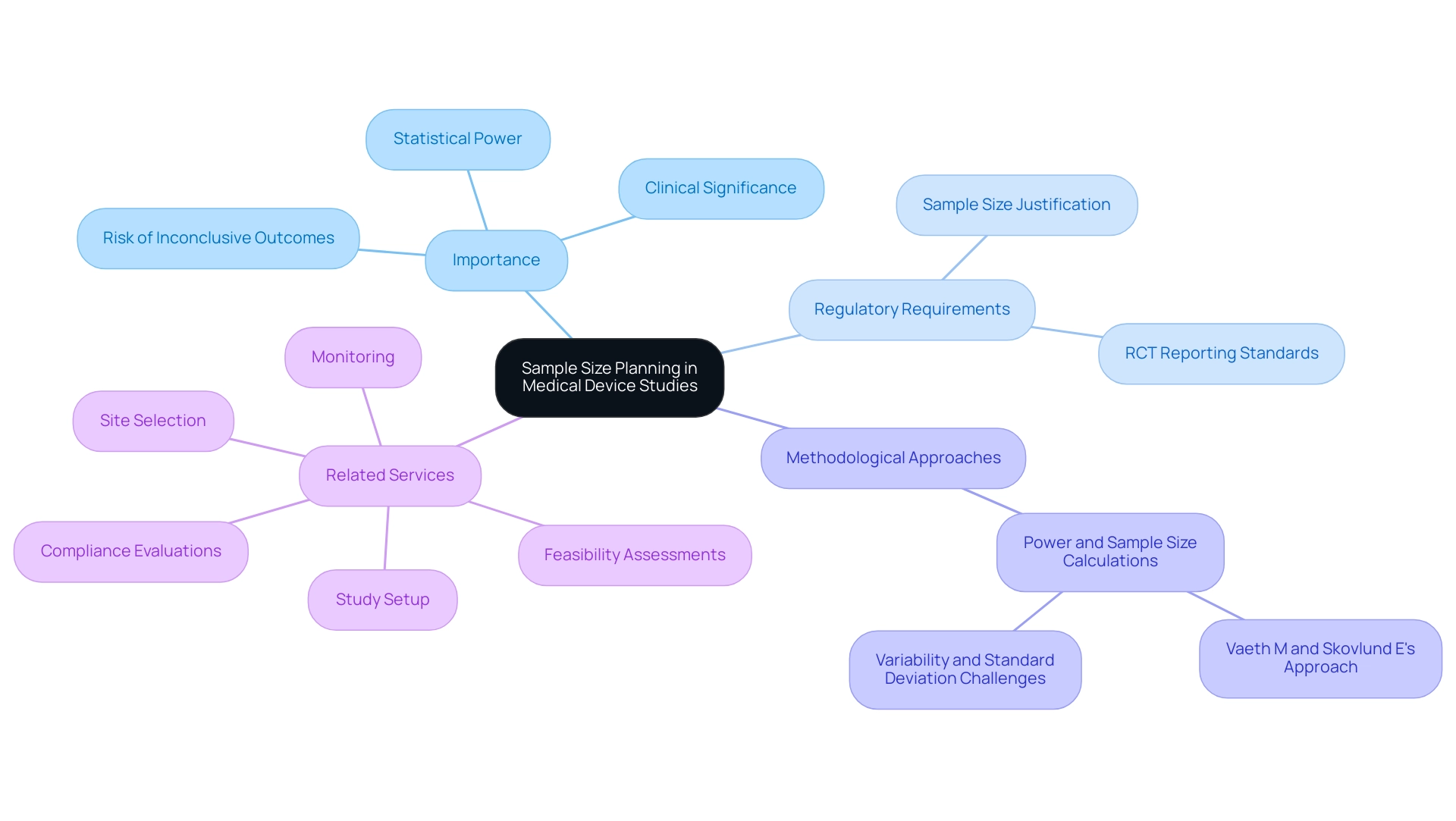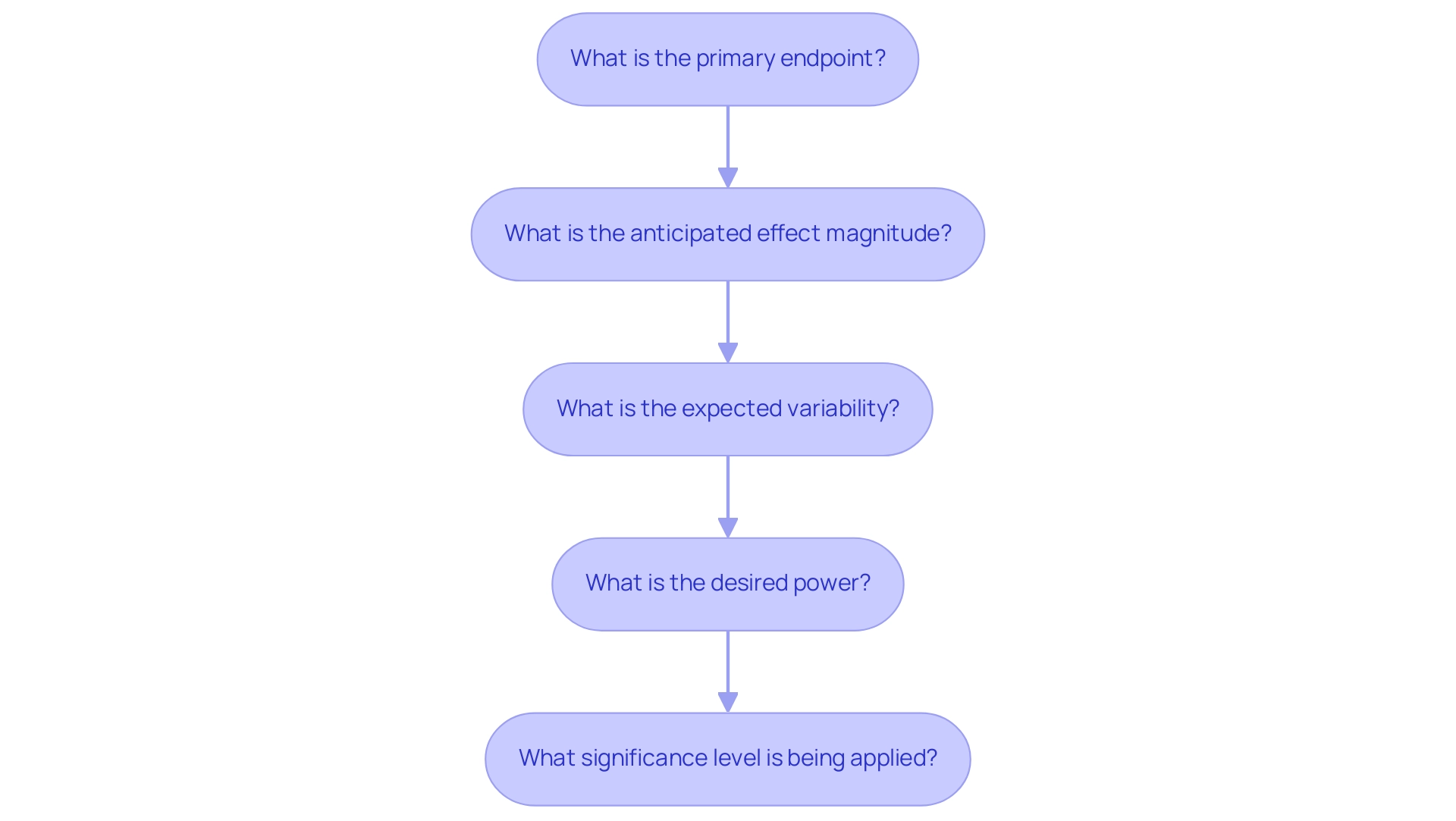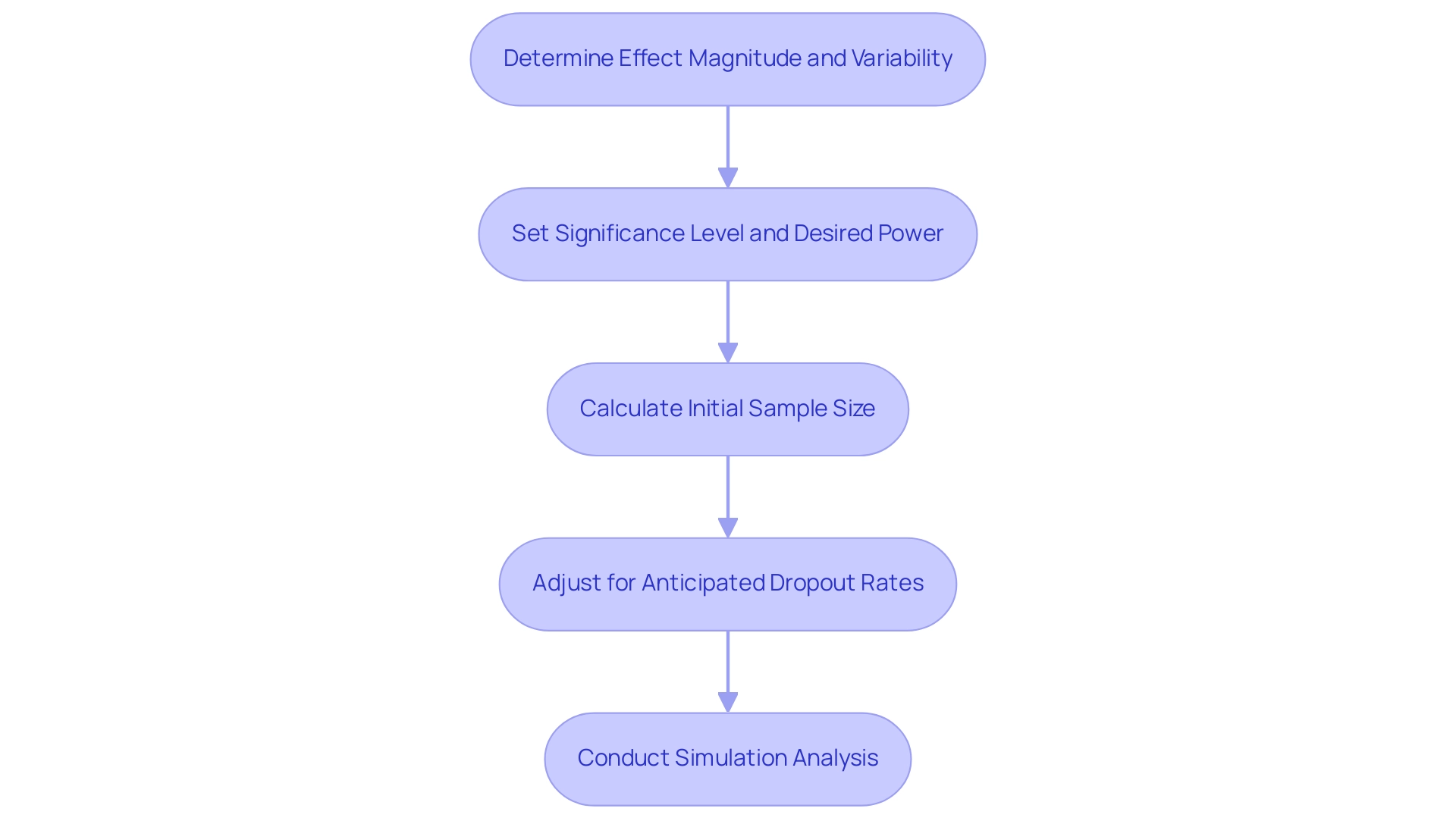Overview
The article focuses on the critical importance of medical device sample size justification in clinical studies, emphasizing that proper planning of participant numbers is essential for ensuring the statistical power needed to detect clinically significant differences. It supports this by detailing regulatory requirements, common challenges in calculations, and the necessity of thorough methodologies, which collectively highlight how accurate sample size justification can enhance the validity and credibility of clinical research outcomes.
Introduction
In the intricate landscape of medical device studies, the significance of sample size planning cannot be overstated. A meticulously determined sample size is foundational to achieving the statistical power required for identifying clinically meaningful differences between treatment groups. This careful planning not only enhances the reliability of study outcomes but also plays a pivotal role in meeting regulatory expectations, as agencies increasingly scrutinize sample size justifications during the approval process.
As the field evolves, understanding the nuances of sample size calculation becomes essential for researchers seeking to navigate the complexities of clinical trials effectively. This article delves into the critical aspects of sample size planning, regulatory requirements, and practical strategies, providing insights that are vital for ensuring the success and integrity of medical device studies.
The Importance of Sample Size Planning in Medical Device Studies
In the field of medical device research, careful planning of participant numbers is crucial for guaranteeing the statistical power needed to identify clinically significant differences between treatment groups. A properly calibrated group not only improves the study's capacity to produce valuable insights but also reduces the chance of inconclusive outcomes, which could threaten the validity of the research. As Kewal Krishan Gupta from the Department of Anesthesiology and Intensive Care observes,
The participant count is the initial and crucial step in designing a clinical study, and any oversight in its assessment may result in the dismissal of an effective medication, while a non-effective medication may receive approval.
Inadequate testing quantities can lead to regulatory obstacles, as governing organizations progressively require thorough justifications for the medical device sample size justification as part of the submission procedure. Recent discussions emphasize that all published randomized controlled trials (RCTs) must report and justify their participant calculations, specifically including medical device sample size justification, underscoring its critical role in adherence and the overall success of the execution. For instance, the related 95% confidence intervals for the mean ultimate load failure fluctuate considerably depending on the number of specimens, spanning from 2683 N to 6408 N for five items to 4248 N to 4844 N for 100 items, demonstrating the effect of quantity on research results.
Moreover, findings from Vaeth M and Skovlund E's research in 'Statistics in Medicine' illustrate a straightforward method for power and group calculations, promoting a clear approach that streamlines the estimation process. Our extensive clinical study management services include:
- Feasibility assessments
- Site selection
- Compliance evaluations
- Study setup
- Monitoring
All designed to assist with medical device sample size justification and precise participant count estimations. Guided by professionals such as Katherine Ruiz in Regulatory Affairs for medical devices in Colombia, this comprehensive approach not only assists in accurate participant calculations but also fosters economic development and healthcare enhancements in local communities through job creation and international cooperation.
Additionally, our services encompass comprehensive reporting on serious and non-serious adverse events, which is essential for ensuring compliance in clinical studies. A case study titled 'Variability and Standard Deviation in Calculation of Cohort' highlights the challenges of incorporating variability and standard deviation into calculations of cohort, emphasizing that accurate estimation is crucial for effective clinical studies.

Navigating Regulatory Requirements for Sample Size Justification
Regulatory organizations like the FDA and the European Medicines Agency (EMA) have outlined clear directives concerning the medical device sample size justification for participant numbers in clinical trials. For instance, ISO 14155 requires that the calculation of the number of participants includes a medical device sample size justification that considers factors such as:
- The anticipated effect magnitude
- Variability among subjects
- The statistical methods planned for analysis
Additionally, the Medical Device Regulation (MDR) requires that clinical investigations must confirm their scientific rigor, which is fundamentally linked to the medical device sample size justification for the precise determination of the number of subjects.
As emphasized in recent discussions, ensuring compliance with these regulations is critical; researchers need to be well-acquainted with evolving standards. Our comprehensive service process addresses these complexities, encompassing:
- Feasibility assessments
- Site selection
- Compliance reviews
- Trial setup, including ethics committee approvals
- Import permits
- Project management
- Detailed reporting on project status, inventory, and adverse events
Significantly, the average proportion for group expansion due to adaptations has been reported at approximately 1.6, emphasizing the significance of these factors in practical applications.
The newest FDA recommendations regarding medical device sample size justification for 2024 emphasize the importance of clarity in determining amounts, reinforcing the idea that well-justified amounts lead not only to strong research but also enhance the credibility of clinical results. Dr. Amir, who has offered insights into this field, emphasizes our proficiency in navigating regulatory guidelines, ensuring the integrity of clinical evaluations. Furthermore, the case analysis titled 'Enrolment Estimation Across Adaptive Designs' demonstrates the difficulties encountered in establishing participant numbers, indicating that fewer than half of the experiments offered details on the operating characteristics of the adaptive designs.
Understanding these regulatory frameworks, along with the challenges posed by recruitment issues and financial constraints faced by medical device startups, is essential for conducting high-quality research that incorporates medical device sample size justification and meets both scientific and ethical standards.
Key Questions for Effective Sample Size Calculation
When determining the appropriate sample size for a clinical study, researchers must carefully consider several critical questions related to medical device sample size justification:
- What is the primary endpoint of the study? This defines the main outcome that the trial aims to assess.
- What is the anticipated effect magnitude based on prior research? Comprehending the effect magnitude is essential as it indicates the expected difference between research groups.
- What is the expected variability in the data? This variability can significantly affect the amount needed to identify meaningful effects.
- What is the desired power of the research, typically set at 80% or 90%? A higher power reduces the chance of a Type II error, ensuring that a true effect is less likely to be overlooked.
- What significance level is being applied, commonly set at 0.05? This level indicates the threshold for statistically significant results.
Addressing these questions not only ensures that the calculated group dimension is statistically valid but also supports medical device sample size justification, upholding ethical standards and safeguarding participant welfare while maintaining the integrity of scientific findings.
In recent research, it has been highlighted that appropriate calculations of the number of subjects, specifically for medical device sample size justification, should be reported and justified in all published randomized controlled experiments (RCTs). Additionally, among randomized study protocols that include a calculation of participant quantity, a significant 4-40% fail to detail all components of the medical device sample size justification, emphasizing the need for thoroughness in study design.
For example, in the research titled 'Estimation for Pain Reduction,' an active-controlled randomized experiment aimed to assess Drug A's effectiveness in alleviating pain, determining a total number of 200 participants (100 in each group) to detect a clinically important difference with 80% power and a 5% level of significance.

Practical Examples of Sample Size Calculations in Clinical Studies
In the realm of clinical trials for cardiac devices, the medical device sample size justification is crucial to ensure valid and reliable outcomes. For instance, in an evaluation of a new cardiac device, researchers may expect an effect magnitude of 0.5 with a variability of 1.0. With a significance level set at 0.05 and a desired power of 80%, statistical software can be employed to determine that approximately 100 participants are necessary for the research.
However, when accounting for anticipated dropout rates, which might be estimated at 10%, researchers must adjust their calculations accordingly. This modification could raise the overall participant count to around 111 individuals to preserve the validity of the findings. Notably, a simulation analysis involving 10,000 independent simulation runs can further illustrate the robustness of such calculations.
By meticulously applying these calculations and adjustments, researchers can ensure adequate participant representation, which is crucial for the medical device sample size justification, thereby enhancing the reliability and robustness of their results. Incorporating such methodologies into the planning phases of multi-center studies is crucial for medical device sample size justification and attaining precise participant number estimations, as highlighted by T. Friede in his discussions on participant number calculation in multi-center clinical studies.
Moreover, bioaccess® provides extensive clinical research management services, including feasibility assessments, site selection, and compliance evaluations, which are essential for successful execution.
With over 20 years of experience in Medtech, bioaccess® specializes in managing:
- Early-Feasibility Studies (EFS)
- First-In-Human Studies (FIH)
- Pilot Studies
- Pivotal Studies
- Post-Market Clinical Follow-Up Studies (PMCF)
A case study titled 'Sample Quantity Estimation for Pain Reduction' demonstrates this point; in an active-controlled randomized experiment aimed at evaluating Drug A's effectiveness in alleviating pain, the total number of participants required was determined to be 200 individuals, accounting for a 10% dropout rate, to detect a clinically significant difference of 0.5 points with 80% power and a 5% level of significance.
With bioaccess® as a vetted CRO and consulting partner, U.S. medical device companies can navigate these complexities efficiently in Colombia.

Common Challenges in Sample Size Justification and How to Overcome Them
Researchers often encounter significant challenges with medical device sample size justification when justifying sample quantities, including:
- Underestimating variability
- Neglecting to account for dropout rates
- Inaccurately calculating effect sizes
These common pitfalls can jeopardize the validity of clinical trials. To successfully navigate these challenges, it is crucial for researchers to perform thorough literature reviews, which can offer valuable insights into prior research and improve the precision of variability and effect measurements.
Furthermore, incorporating a buffer for possible dropout rates during participant calculations is crucial to reduce the risk of underpowered research. Engaging statisticians in the early stages of planning is critical; their expertise can refine calculations and offer essential insights, ultimately leading to more robust and credible research outcomes.
A good medical device sample size justification in qualitative research involves:
- Identifying populations
- Estimating codes
- Defining sampling strategies
Furthermore, the overarching goal is to ensure that the target difference is considered important to at least one key stakeholder group, which is vital for ethical research relevance. A case analysis titled 'Challenges in Defining Target Differences' illustrates that prior research often lacks depth or may introduce bias, complicating the establishment of a credible target difference.
This case study emphasizes the necessity of involving key stakeholder groups in defining both the estimand and target difference to ensure that the research remains ethically sound and relevant. As Kruschke notes regarding Bayesian estimation, an uninformative prior can yield similar credible intervals, which underscores the importance of establishing a well-defined foundation for medical device sample size justification.
Conclusion
Meticulous sample size planning is undeniably a cornerstone of successful medical device studies. As outlined, carefully calculating the sample size not only enhances the statistical power necessary for detecting meaningful differences between treatment groups but also aligns with regulatory expectations that have become increasingly stringent. The implications of improper sample size estimation can be severe, potentially leading to regulatory setbacks and jeopardizing the integrity of clinical trials.
Understanding the regulatory requirements and methodologies for sample size justification is essential for researchers. The insights shared regarding the guidelines from bodies such as the FDA and EMA emphasize the importance of transparency and rigorous justification in study designs. By addressing key questions around effect size, variability, and desired power, researchers can ensure that their studies are not only scientifically valid but also ethically sound.
Furthermore, practical examples and case studies illustrate the real-world applications of these principles, showcasing the necessity for adjustments to account for dropout rates and other variables. Engaging with experienced statisticians and conducting thorough literature reviews are critical strategies for overcoming common challenges in sample size justification.
In summary, a well-planned sample size is crucial for the credibility and success of clinical trials in the medical device sector. As researchers navigate the complexities of trial design and regulatory compliance, the importance of diligent sample size calculations cannot be overstated. By prioritizing this foundational element, the medical community can enhance the reliability of study outcomes, ultimately leading to advancements in healthcare and improved patient care.
Frequently Asked Questions
Why is participant number planning important in medical device research?
Careful planning of participant numbers is crucial to ensure the statistical power needed to identify clinically significant differences between treatment groups, improving the study's capacity to produce valuable insights and reducing the chance of inconclusive outcomes.
What are the consequences of inadequate participant numbers in clinical studies?
Inadequate participant numbers can lead to regulatory obstacles, potentially resulting in the dismissal of effective medications or the approval of non-effective ones. It can also threaten the validity of the research.
What do regulatory organizations require regarding participant numbers in clinical trials?
Regulatory organizations like the FDA and EMA require thorough justifications for medical device sample sizes, including factors such as anticipated effect magnitude, variability among subjects, and planned statistical methods for analysis.
What services are offered to assist with medical device sample size justification?
Services include feasibility assessments, site selection, compliance evaluations, study setup, and monitoring, all aimed at assisting with accurate participant count estimations.
How does the average proportion for group expansion affect clinical trials?
The average proportion for group expansion due to adaptations has been reported at approximately 1.6, highlighting the importance of considering these factors in practical applications.
What recent recommendations have been made by the FDA regarding medical device sample size justification?
The newest FDA recommendations emphasize the importance of clarity in determining participant numbers, reinforcing that well-justified amounts lead to strong research and enhance the credibility of clinical results.
What challenges do researchers face regarding participant numbers in medical device studies?
Researchers encounter challenges such as recruitment issues, financial constraints, and the need to comply with evolving regulatory standards, all of which are essential for conducting high-quality research.
What is the significance of the case studies mentioned in the article?
Case studies highlight the difficulties in establishing participant numbers and the need for clear reporting and justification of sample sizes in clinical trials, emphasizing the importance of accurate estimation for effective research outcomes.




